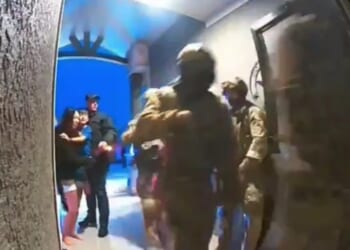South Korea, with US support, restored a grounded F-35A by pioneering wing-removal transport. This saved millions of dollars and bolstered future repairs in the F-35 sustainment program.
The US-led F-35 Joint Program Office (JPO) aided the Republic of Korea Air Force (RoKAF) in refurbishing its damaged Lockheed Martin F-35A Lightning II, previously considered irreparable and a write-off. After colliding with an eagle, the RoKAF F-35A was forced to make an emergency landing at the Seosan Air Base in early January 2022.
The bird strike resulted in a landing gear malfunction, which resulted in a belly landing for the fifth-generation stealth fighter. The damage was significant enough that the aircraft couldn’t be returned to service.
However, it was determined that the damaged F-35 Lightning II could still be employed as a training platform for mechanics.
There was one problem, however: The aircraft couldn’t fly again. Though Seosan Air Base is just 60 miles from Cheongju Air Base, the two-lane highways didn’t offer enough room for an airplane with a 35-foot wingspan. Instead of closing roads, the RoKAF detaches the fighter jet’s wings and reattaches them.
“Leveraging expertise developed during prior JPO reuse efforts, the team devised a plan to remove and reinstall the aircraft’s wings, enabling a safer and more cost-effective transfer. With ROKAF approval, the damaged F-35A served as a testbed for this new capability,” the JPO explained in a media release.
The RoKAF operates 39 F-35s, and its program of record calls for an additional twenty stealth fighters. Deliveries are slated to begin in 2027.
Lockheed Martin Works with the South Koreans to Repair the F-35s
Though it might seem like a small project, it still required a “coordinated team” that included “representatives from Lockheed Martin, the F-35 Lightning Support Team, ROKAF Logistics Command, ROKAF’s 17th Fighter Wing, the US Air Force’s 309th Expeditionary Deployed Maintenance Squadron, and the US Navy’s Forward Deployed Combat Repair and Fleet Readiness Center Southeast.“
Several weeks were spent removing the wings, which hadn’t been damaged in the emergency landing.
“This was a significant challenge, as it was the first attempt at removing F-35 wings as part of a concept demonstration,” explained Matt Trodden, LST Aircraft Crash Recovery lead engineer.
“Despite early doubts, the team worked seamlessly and completed the operation several weeks ahead of schedule, validating the feasibility of wing removal and reinstallation.”
The JPO saw this operation as a “proof-of-concept” that demonstrated that wing replacement could be both “practical” and an “effective capability” within the F-35 sustainment program. It even resulted in the “integration of wing removal and reinstallation procedures into the F-35 program’s standard heavy maintenance, repair, and reuse protocols,” which could pave the way for further maintenance of damaged Lightning IIs.
The F-35 Repairs Will Save Millions of Dollars
This effort follows the successful “Franken-plane” effort by the JPO, Lockheed Martin, and the US Air Force, which merged two damaged F-35s into one functional combat-capable aircraft.
Following a feasibility study, the F-35 JPO successfully began reconstructing the AF-211 aircraft, which had experienced a nose landing-gear separation in June 2020. It received an undamaged nose section from AF-27, another Lightning II that suffered a serious engine fire six years earlier at Eglin Air Force Base (AFB), Florida.
The US Air Force’s 388th Maintenance Group at Hill AFB, Utah, is using a cockpit that was taken from an F-35B, the short takeoff and vertical landing (STOVL) variant of the Lightning II operated by Marine Fighter Attack Squadron 501 (VMFAT-501), as a training aid. That aircraft crashed at Marine Corps Station Beaufort in September 2018.
These efforts are likely worth the cost, given that each training unit for the F-35 costs around $10 million. Repurposing the damaged aircraft is a way to get some of that money back.
About the Author: Peter Suciu
Peter Suciu has contributed over 3,200 published pieces to more than four dozen magazines and websites over a thirty-year career in journalism. He regularly writes about military hardware, firearms history, cybersecurity, politics, and international affairs. Peter is also a Contributing Writer for Forbes and Clearance Jobs. He is based in Michigan. You can follow him on Twitter: @PeterSuciu. You can email the author: [email protected].
Image Credit: Shutterstock/ranchorunner.















